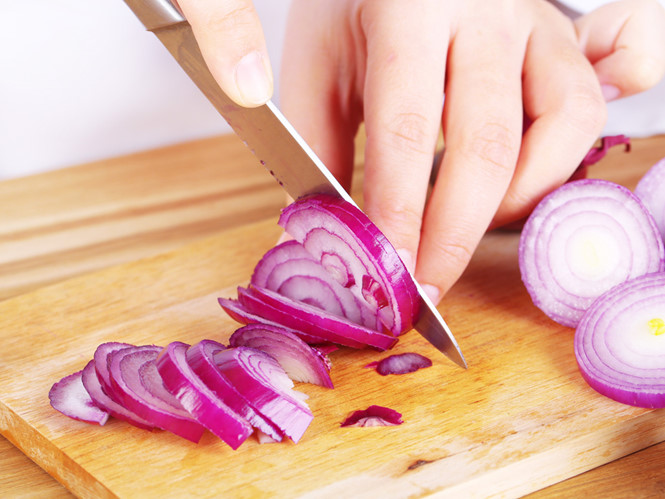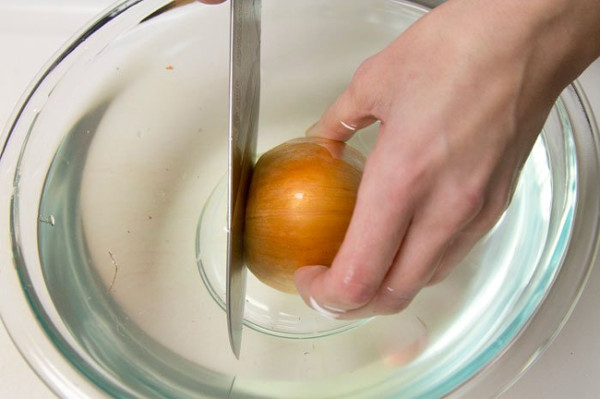It turns out that this is the reason why we shed tears
When operating, we often experience uncomfortable, itchy, spicy and watery feelings.
- It turned out that this was the reason that only one side of the nose was suffocated with the flu
- The reason why the eyes wake up every morning and full of rust will surely surprise you
- The culprit causes hair loss when we get older
According to the researchers, the cause of lacrimation is the propanthial s-oxide irritant.

The administrative propanthial s-oxide volatile compound is the cause of tearing.(Photo: Vix.)
Propanthial s-oxide is a volatile chemical. When we cut, propanthial s-oxide will quickly evaporate and find its way to the eye. This substance quickly combines with water covering the surface of the eye to form sulphenic acid - a substance that stimulates the lacrimal glands. The brain quickly receives a warning that there is a stimulant and it signals down the tear glands that make you blink and tear. The amount of acidic acid produced is so small that it does not harm but only irritates the eyes.
In order to produce a compound that causes watery eyes to propanthial s-oxide, onion plants require two enzymes.
First, the onion plants absorb sulfur in the soil and store it in the compound PRENCSO 1 (1-propenyl-L-cysteine sulphoxide). When cut, the onions release allicinase, which reacts with PRENCSO 1 to produce ammonia and 1-propenyl sulfenic acid. The second enzyme converts 1-propenyl sulfenic acid to propanthial s-oxide.

The ability to make onion's tears depends on the sulfur that plants absorb in the soil. High or low sulfur levels depend on the type of soil and the condition of the growing tree.
Garlic and onions have close relatives, but the garlic does not cause tearing because it contains another compound called allii or PRENCSO 2. This compound produces allici, a substance that is beneficial to human health, not broken structure into propanthial s-oxide.

Simple tips to help cut onions without tears
- Cut onions quickly with sharp knives. The faster the act, the less enzymes that cause eye irritation.
- Leave onion in the freezer for 10-15 minutes before cutting.
- Cutting the onions next to a pot of boiling water, the hot steam will blow away the 'crying' enzyme.
- Soak in water before cutting.
- Breathing by mouth when the onions will help the olfactory nerves located near the tear ducts will not feel the spicy taste of onions.
- Chewing bread or chewing gum will help 'suck' this eye-stinging gas into your tongue, thereby reducing the risk of stinging.
- Cutting onions under a hood or putting a fan in the right direction will cause the tear gas to dispel in the air.
You should read it
- 6 interesting facts about tears make you startled by surprise
- The special gun turns your tears into true weapons literally
- Smiling tears, have you ever been like that? But why is that so?
- 5 unexpected benefits of tears have been scientifically proven
- Tears may be the key to early diagnosis of Parkinson's disease
- Review who Thuong's movie is, the opposite of tears, .. on VTV
- Rounded his eyes to see the bullet shatter when shot at the glass of 'Dutch tears'
- 11 surprising uses of refrigerators not everyone knows
- What does it mean to eat onions? What does it mean?
- 'Laughing out of tears' topped the list of the 10 most popular emojis in the world
- Growing onions in a glass of water can both decorate and help reduce stress, prevent the flu
- Thai alphabet
May be interested

The sundial does not use batteries, electricity or any motor

Revealing 4 immortal magic tricks that 99% of people still wonder

The skyscraper towers upside down from the top to the foundation in Spain

When it comes to rain, running or walking is the least wet?

Stun with automatic cooking lines without Japanese cooks

This is the only part of the body that never 'goosebumps'.






 6 interesting facts about tears make you startled by surprise
6 interesting facts about tears make you startled by surprise Smiling tears, have you ever been like that? But why is that so?
Smiling tears, have you ever been like that? But why is that so? The special gun turns your tears into true weapons literally
The special gun turns your tears into true weapons literally 5 unexpected benefits of tears have been scientifically proven
5 unexpected benefits of tears have been scientifically proven Tears shed with a series of 'technology intense' pictures that young people after 2000 will not be able to understand
Tears shed with a series of 'technology intense' pictures that young people after 2000 will not be able to understand Tears may be the key to early diagnosis of Parkinson's disease
Tears may be the key to early diagnosis of Parkinson's disease